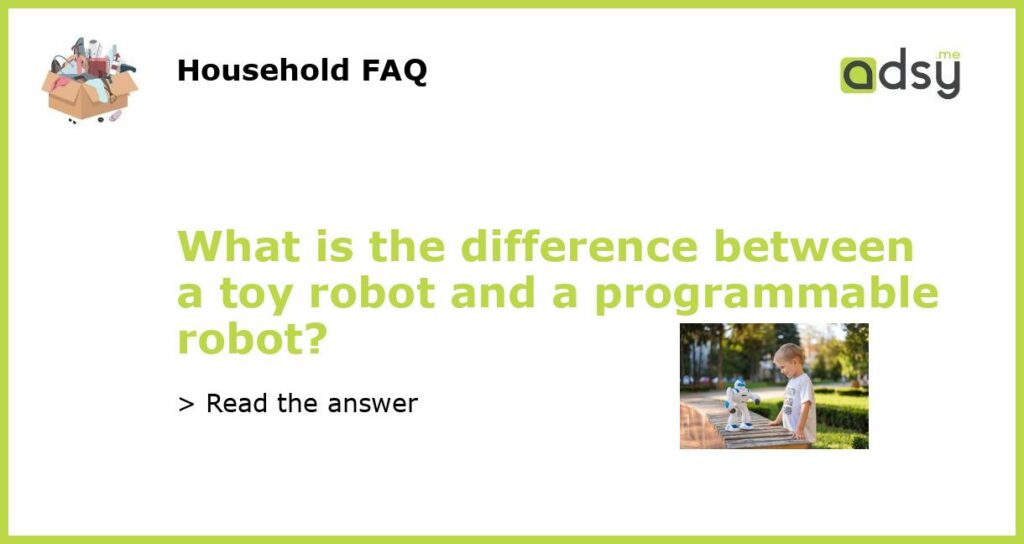The Difference Between a Toy Robot and a Programmable Robot
Toy robots and programmable robots are both popular among children and adults alike. However, there are significant differences between the two. Toy robots are typically designed for entertainment purposes, while programmable robots are designed for educational and functional purposes. In this article, we will explore the key differences between a toy robot and a programmable robot.
Purpose and Functionality
Toy robots are primarily designed for entertainment purposes. They can perform various pre-programmed actions, such as walking, talking, dancing, or shooting foam missiles. These actions are usually controlled by buttons or remote controls. Toy robots are often made with colorful designs and sound effects to attract and engage children.
On the other hand, programmable robots are designed for educational and functional purposes. They are equipped with sensors, motors, and other components that allow users to program and control their actions. Programmable robots can be used to teach coding and programming concepts, problem-solving skills, and logical thinking. They can perform a wide range of tasks, such as following lines, avoiding obstacles, grabbing objects, and even interacting with their environment.
Learning Experience
Toy robots provide a more passive learning experience. Users can enjoy watching the robot perform its pre-programmed actions, but they do not have much control or input in the robot’s behavior. Toy robots are designed to be intuitive and easy to use, allowing children to have fun without the need for complex instructions or programming skills.
Programmable robots, on the other hand, offer a more hands-on learning experience. Users can program the robot’s behavior using coding languages or visual programming interfaces. This process requires problem-solving skills, logical thinking, and creativity. By programming a robot, users can learn about concepts such as sequencing, loops, conditional statements, and variables. They can also experiment and iterate on their programs to achieve different results.
Flexibility and Customization
Toy robots usually have a fixed set of actions and behaviors that cannot be easily modified or customized. The pre-programmed actions are often limited to a few basic movements or interactions. While toy robots can provide entertainment value, they may not offer much in terms of flexibility or long-term engagement.
Programmable robots, on the other hand, are highly flexible and customizable. Users can adapt the robot’s behavior to suit their needs and interests. They can create unique programs and explore different possibilities. Programmable robots often come with a variety of sensors and inputs, such as ultrasonic sensors, line-tracking sensors, and touch sensors. This allows users to expand the robot’s capabilities and create more sophisticated and interactive behaviors.
Age Range and Skill Level
Toy robots are suitable for a wide age range, including young children who are not yet capable of programming or understanding complex concepts. The simplicity of toy robots makes them accessible to young users and provides a fun and interactive experience. However, older children and adults may find toy robots less engaging or challenging due to their limited functionality.
Programmable robots, on the other hand, are designed for older children, teenagers, and adults. They require a certain level of cognitive ability, problem-solving skills, and programming knowledge. However, there are programmable robots available for different age groups and skill levels. Some robots are designed for beginners and provide a gentle introduction to programming, while others are more advanced and suitable for experienced users.
Price Range
Toy robots are generally more affordable compared to programmable robots. They are often made with lower-cost materials and offer limited functionality. Toy robots can range in price from a few dollars for simple wind-up or remote-controlled robots to several hundred dollars for more advanced models with additional features.
Programmable robots, on the other hand, tend to be more expensive due to their advanced functionality and components. They often come with additional accessories, such as expansion kits or programming software. Programmable robots can range in price from around $50 for basic entry-level models to several hundred dollars for more advanced robots with advanced sensors and capabilities.
In conclusion, the main differences between a toy robot and a programmable robot lie in their purpose, functionality, learning experience, flexibility, age range, and price range. While toy robots offer entertainment value and a passive learning experience, programmable robots provide educational opportunities, hands-on learning experiences, customization options, and a wide range of applications. Ultimately, the choice between a toy robot and a programmable robot depends on the user’s interests, goals, and level of engagement.






